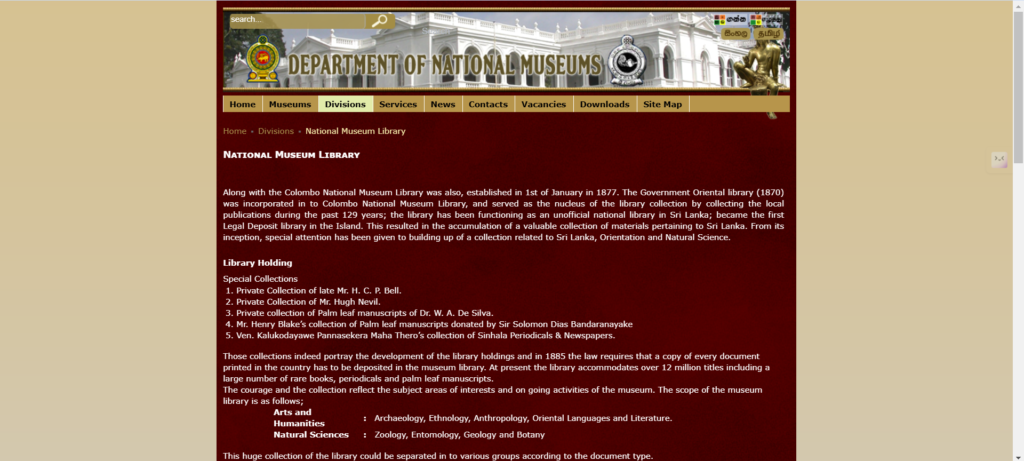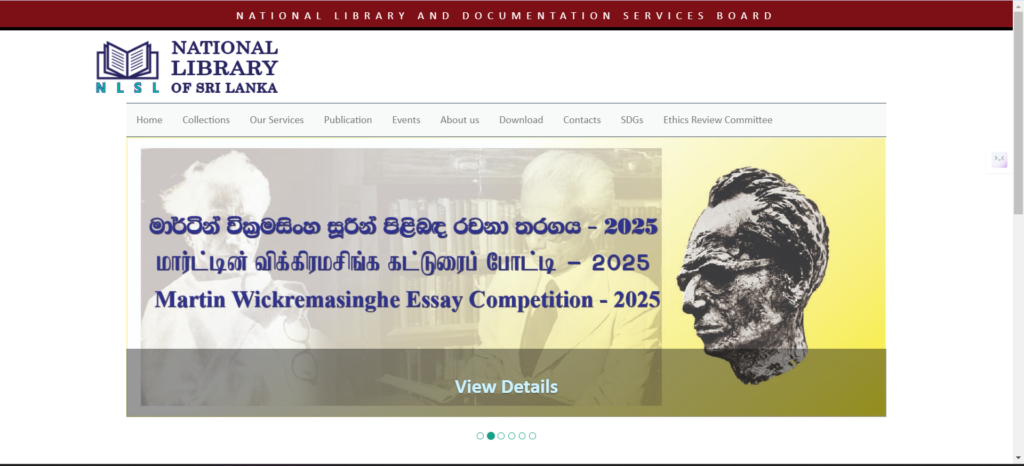Sri Lanka, a nation celebrated for its rich cultural and historical heritage, houses several important libraries that preserve, study, and share knowledge about its diverse history, art, and literature. Two of the most significant libraries are the Sri Lanka National Museum Library and the National Library of Sri Lanka. Each institution has a unique role in preserving the nation’s literary, historical, and artistic heritage, serving as gateways to understanding Sri Lanka’s multifaceted past and present.
The Sri Lanka National Museum Library
The Sri Lanka National Museum Library is part of the Colombo National Museum, which was established in 1877 by the British colonial government. This library is not only one of the oldest in the country but also among the most respected, attracting researchers, historians, and visitors who are keen to learn about Sri Lanka’s cultural and archaeological heritage.

History and Mission
The National Museum Library was established shortly after the museum itself, with the mission of supporting the museum’s objective to collect, conserve, and share the cultural and historical artifacts of Sri Lanka. This library serves as an archive of the museum’s collections, housing an array of books, manuscripts, and rare documents that document Sri Lanka’s historical, anthropological, and cultural evolution.
Collections and Resources
The Sri Lanka National Museum Library is renowned for its extensive collections that span a broad range of subjects, with a strong focus on anthropology, archaeology, and the arts. The library contains over 12,000 books and manuscripts, with some dating back centuries. Among its prized possessions are rare palm-leaf manuscripts which are handwritten documents made on palm leaves—a traditional method used in South Asia for centuries.
One of the unique aspects of the library’s collection is its extensive repository of colonial-era publications, including journals, travelogues, and other writings that provide insight into Sri Lanka’s colonial past. These documents are invaluable for understanding how colonial powers documented, interpreted, and often misinterpreted Sri Lankan culture.
Rare Manuscripts and Antiquities
Among the most prized items in the National Museum Library are its Ola leaf manuscripts. These are written on leaves of the Ola palm, inscribed with texts in Pali, Sanskrit, and Sinhala. The manuscripts encompass Buddhist texts, classical literature, medicinal recipes, and local administrative records from ancient times. Some of these manuscripts date back centuries and provide a fascinating insight into early Sri Lankan governance, culture, and spirituality.
The library’s holdings also include rare maps and lithographs that depict Sri Lanka in earlier eras, showcasing its changing geographical and political landscapes. This visual documentation helps researchers track the evolution of the nation’s territories, coastal lines, and political boundaries.
Facilities and Services
The Sri Lanka National Museum Library offers a range of services for scholars and visitors. Its reference library allows the public to study the materials on-site, providing access to resources that are otherwise difficult to find. While the library’s materials cannot be borrowed, photocopying and digital scanning services are available to assist researchers in gathering information.
The library has recently taken steps towards digitization, making some of its collections available online. This effort allows for the preservation of fragile materials and expands access to international researchers. Despite limited online offerings so far, digitization efforts are expected to grow over time.
The National Library of Sri Lanka
Established in 1990, the National Library of Sri Lanka (NLSL) serves as the country’s main repository for published materials and as a hub for public literacy and information access. Located in Colombo, the library has become a central pillar of Sri Lanka’s information infrastructure and an invaluable resource for scholars, students, and the general public.

Mission and Goals
The National Library’s mission extends beyond mere preservation; it aims to promote literacy, education, and lifelong learning among all Sri Lankans. The library strives to provide equal access to information, bridging educational gaps and helping to uplift underprivileged communities.
Collections and Resources
The National Library’s collections are more extensive and diverse than those of the Museum Library, encompassing over a million items. The library’s collections include books, periodicals, government publications, and special collections that cover a broad range of topics from local literature and history to global sciences and technology. Additionally, the library houses works in Sinhala, Tamil, and English, reflecting Sri Lanka’s multilingual identity.
One unique section of the library is its Sri Lanka Collection, which consists of materials that are related specifically to the country’s history, culture, and people. This collection is invaluable for researchers focusing on Sri Lanka’s political, social, and cultural landscape, offering resources on topics ranging from ancient history and Buddhist studies to modern political movements.
Special Collections
The National Library is also home to several special collections. These include a Rare Books Collection, containing first editions and other significant works that are important for both historical and literary reasons. There is also an extensive collection of newspapers and periodicals, which are key resources for studying the daily lives, public opinion, and historical events of past decades.
In addition, the library houses an Oral History Collection which includes interviews and audio recordings of prominent Sri Lankan figures. This unique archive preserves the voices and stories of Sri Lanka’s past, providing future generations with an authentic record of the nation’s memories.
Digitization and Modernization
In recent years, the National Library has embraced digitization efforts to make its resources more accessible and preserve fragile items. The National Library’s Digital Library Project is an ongoing effort to create a digital archive of the country’s important documents and texts. This is particularly important in a tropical country where materials can easily deteriorate due to humidity and other environmental factors.
Outreach and Educational Programs
One of the National Library’s key roles is to encourage public literacy and education. To achieve this, the library hosts a variety of educational and cultural programs for children, teenagers, and adults. These programs range from reading clubs and storytelling sessions to workshops and seminars on topics like research skills, digital literacy, and language learning.
The National Library also has an extension program that includes mobile libraries and satellite branches across the country, bringing books and learning resources to rural and underserved areas. Through these outreach efforts, the library strives to ensure that everyone in Sri Lanka, regardless of their location or socio-economic background, has access to information and educational resources.
Key Differences and Shared Missions
The Sri Lanka National Museum Library and the National Library of Sri Lanka serve complementary roles. While the Museum Library focuses on cultural and historical documentation relevant to the museum’s collections, the National Library functions as the country’s primary repository for all published materials. Together, these libraries preserve Sri Lanka’s literary and historical heritage, serving as valuable resources for students, researchers, and the general public.
Both libraries are also embracing digitization and modernization to improve access and protect their collections from environmental decay. This is especially significant as Sri Lanka’s heritage items are fragile and require careful handling and preservation techniques to ensure their longevity.
A Legacy of Knowledge and Culture
The Sri Lanka National Museum Library and the National Library of Sri Lanka are vital institutions that play distinct but complementary roles in preserving and promoting the nation’s rich cultural heritage and knowledge. Whether through rare manuscripts, extensive research resources, or educational outreach, these libraries contribute to Sri Lanka’s intellectual and cultural fabric.
For anyone interested in exploring Sri Lanka’s history, literature, or cultural diversity, these libraries offer a gateway into the heart of the nation. As they continue to expand their digital offerings and reach new audiences, they are ensuring that Sri Lanka’s heritage will be preserved and accessible for generations to come.








